Prices have been brought up to date, and are for stamps in 'average' condition. The currency is now selectable, the default is British Currency (£). I have revised Hiscocks' original listing, though leaving references to the original designations. The new designations have 'RH' numbers (Revised Hiscocks) to avoid confusion. Setup |
Steve Hiscocks wrote:
This company was set up in 1861 to exploit an improved print-out technique. It is generally supposed that the company never in fact acquired
any lines or transmitted any messages but that the stamps were produced by Waterlow and Sons in anticipation. However a note written some fifty
years later in 1908 by a man previously associated with the company (Morley's Philatelic Journal) recalls their having a single line from Manchester
to Liverpool and suggests that a few stamps were in fact used although the company did very little business. The second design of the 3d value (No.5)
was issues in a booklet (seven sheets of 12 (3 x 4) completely surrounded by selvedge, plain thin covers, sewn, numbering alternatively left to right
and right to left down each sheet). This is thought to be in the first production of a stamp booklet anywhere in the world, predating the London and
District (q.v) by a year, the Californian State Telegraph Co. by eight to nine years and the first postage stamps by 28 years.
According to DistantWriting.co.uk this combined with some unfortunate weather caused a lack of confidence in the company.
Their share issue of March 1864 was ignored and they were unable to pay the Economic Telegraph Company,
who then sued for its money the courts then froze the companies bank account leading to failure of the company in June 1864.
By 1865 it was looking to lease its wires to other telegraph companies.
Note on perforations: There is a difference of opinion between Hiscocks and L&H on the perforations of most of these.
Hiscocks says they all have Perf.12¾ except for H2a (Perf.12) and H5 (Perf.13).
L&H say that only the normal 6d is this size and all the rest (except H2a) are Perf. 12½.
I find that apart from H2a they measure about Perf. 12.6 to 12.7 so perhaps Perf. 12¾ would be more accurate.
I put the differences of opinion down to somewhat uneven perforations. It should be noted though that they were not all perforated the same.
The 6d sheet ending with 19100 was perforated along the bottom edge and (at least) the right side, but not the top.
The 1s sheet ending with 4100 was printed along the top and (at least) the right side, but 3520, 3690 and 3830 are not perforated down the right side,
The 3d numbered 2210 is also not perforated on the right side.
Like the Universal Private Telegraph Company stamps, these were printed in sheets of 100.
In each row, the second series of 5 matched the first, so that any variety was repeated every 5th stamp.
Both companies had their stamps printed by Waterlow and Sons on T. H. Saunders watermarked paper.
T. H. (Thomas Harry, 1813-1870) Saunders established half a dozen paper mills in the Dartmouth area of Kent, England.
He supplied both laid and wove paper to Perkins, Bacon among others.
Since this disagrees with Langmead & Huggins assertion of 8 x 10 stamps per sheet (copied from Raymond Lister, 1961),
I give the evidence of this on the Bonelli's_Evidence page.
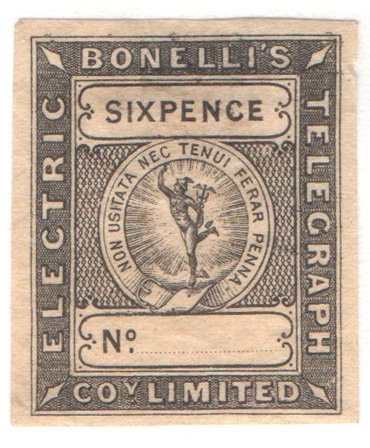 |
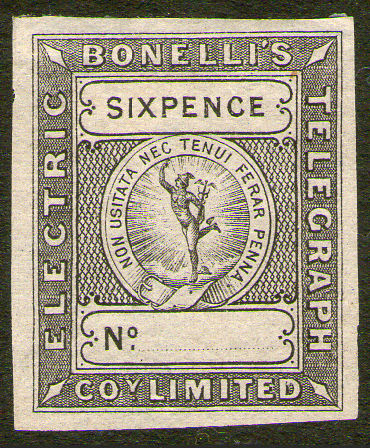 |
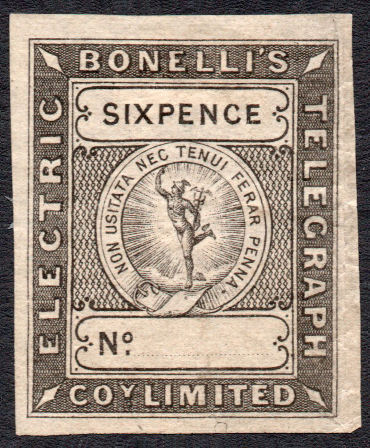 |
| RH2c (column-2/7 - courtesy of Les Bottomley ) | RH2c (column-4/9) | RH2d (column-5/0) - courtesy of Steve Lawrie |
| RH # | Hisc. | Description | Rarity | Mint | Used |
|---|---|---|---|---|---|
| RH1 | H1 | 3d bright green (tall 'THREEPENCE') | Common | 20.00 | - |
| RH1a | H1a | 3d bright green (short 'THREEPENCE') | Common | 30.00 | - |
| RH1b | - | 3d bright green (both sizes in pair) | R5 | - | - |
| RH1c | - | 3d bright green scratch on buckle | Common | 30.00 | - |
| RH2 | H2 | 6d black | Common | 20.00 | - |
| RH2a | H2a | 6d dark grey Perf.12 (first 100 sheets) | Common | 50.00 | - |
| RH2b | - | 6d dark grey scratch on buckle | Common | 30.00 | - |
| RH2c | H2b | 6d black Imperf. without control. | R3 | 150.00 | - |
| RH2d | - | as RH2c with scratch on buckle. | R3 | 180.00 | - |
| RH2e | - | substituted cliché (known at 94 and 98) | 5 known | 75.00 | - |
| RH3 | H3 | 9d light blue | Common | 20.00 | - |
| RH3a | dot over head of Hermes. | Common | 30.00 | ||
| RH3b | 9d light blue Perf. without control | R4 | 250.00 | ||
| RH4 | H4 | 1s red | Common | 20.00 | - |
| RH4a | short 'L' in 'BONELLI' | Common | 30.00 | ||
| RH4b | 1s red Perf. without control | R4 | 250.00 | ||
| RH5 | H5 | 3d brown (from booklets) | Common | 15.00 | - |
| RH5a | imperf. between pair (2995 - 3076) | ? | 150.00 | - | |
| RH5b | complete pane of 6 | ? | 120.00 | - | |
| RH5c | complete pane of 12 | ? | 300.00 | - |
Look here for an explanation of the table.
The company failed June 1864, though it retained assets that were eventually transferred to the Post Office.
More details at DistantWriting.co.uk.
| Shortcuts to different sections | ||||||||||
| Highest & lowest | Watermark | Plate production | 3d Green | 6d | Substituted cliches | 9d | 1s | Used ? | 3d booklets | Calculator |
| Courtesy of Steve Lawrie. | Courtesy of Brian Callan. | Courtesy of Robert Poposki. | Courtesy of www.ibredguy.co.uk. |
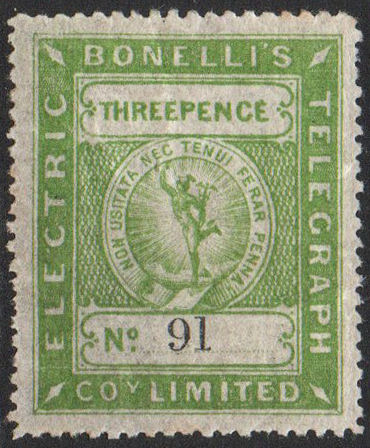 |
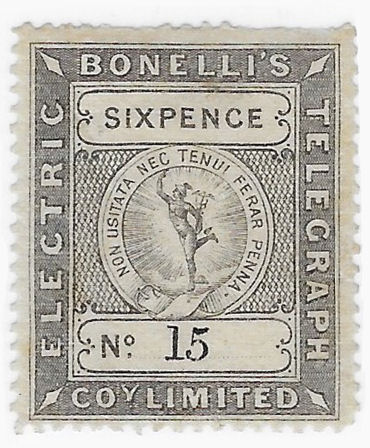 |
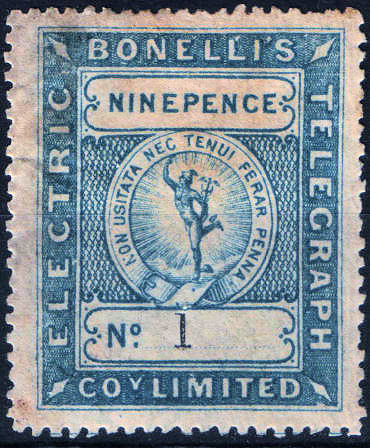 |
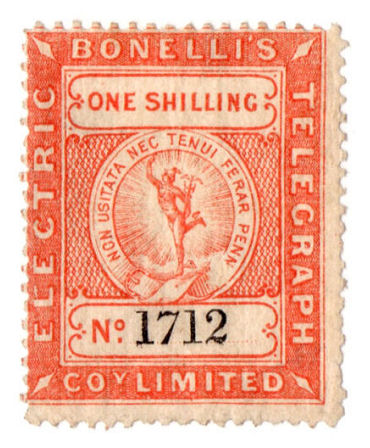 |
| 3d RH1 lowest control known 91 | 6d RH2a lowest control known 15 | 9d RH3 lowest control known 1 | 1s RH4 lowest control known 1712 |
I know of the 3d green in the range of 91 to 9822.
I now know of the 6d black in the range of 15 to 19527, (19515 reported by Langmead & Huggins).
I know of the 9d blue in the range of 1 to 4781.
I know of the 1s red in the range of 1712 to 4996.
| One of mine. | Courtesy of Les Bottomley. | One of mine. | Courtesy of Steve Lawrie. |
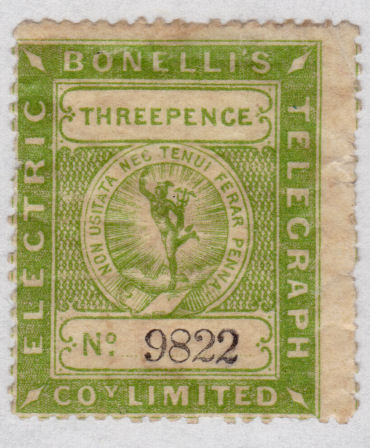 |
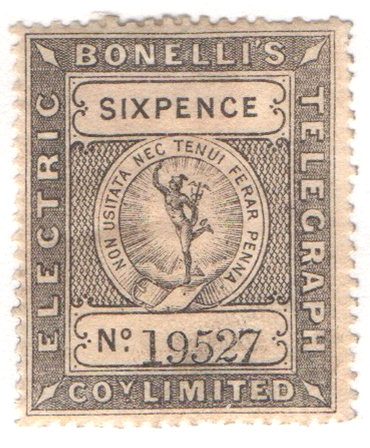 |
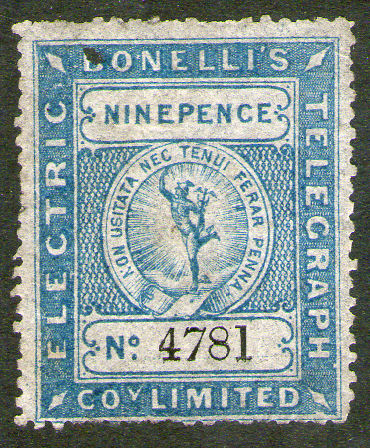 |
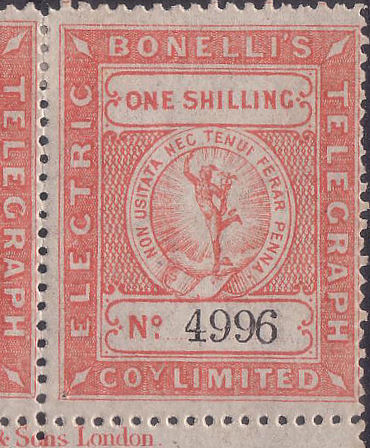 |
| 3d RH1 highest control known 9822 | 6d RH1 highest control known 19527 | 9d RH3 highest control known 4781 | 1s RH4 highest control known 4996 |
Philbrick & Westoby (1881) were of the opinion that no Bonelli stamps were ever used. They stated:
"The stamps are readily procurable, having never been employed for telegraph purposes, and having consequently never been used or destroyed."
If that was the case, then a random selection of stamps should be randomly spread across the sheets printed, for any of the face values.
Look at the figures though:
| Value | Wmk | sheets that examples have been seen from | Sheet Qty | Lowest | Highest | % evident |
|---|---|---|---|---|---|---|
| 3d green | sideways inverted | 0, 2, 21, 22, 23, 38, 42, 43, 45, 49, 50, 51, 55, 68, 84, 85, 97, 98. | 18 | 91 | 9822 | 18.2 |
| 6d black | sideways | 0, 56, 59, 75, 84, 92, 110, 129, 142, 143, 182-186, 187, 188-191, 195. | 21 | 15 | 19527 | 10.7 |
| 9d blue | inverted-reversed | 0-6, 9, 10, 11, 13, 17, 31, 32, 33, 36, 37, 40, 42-47 | 24 | 1 | 4781 | 50.0 |
| 1s red | upright or inv-rev | 17, 27, 29, 32-42, 45, 47, 49 | 17 | 1712 | 4996 | 34.0 |
6d sheets up to sheet 92 at least are Perf.12, sheets 143(98), 184(98) and 187(94) onwards at least are known to have substituted clichés.on the bottom row.
Taking the highest number control for each as an indication of the number of sheets printed, together with the number of sheets that I have seen examples from
provides an interesting statistic, though interpretation is less easy.
One interpretation is that the 3d and 6d values were actually used and subsequently destroyed along with used forms,&
and that the 9d and shilling values were either not used or little used.
I think that 100 sheets of 6d were first printed and perforated guage 12.
Then the 3d was prepared by modifying a copy of the 6d plate and perhaps 50 sheets of each were printed and perforated in guage 12½.
At some later date the 9d and 1s plates were freshly prepared and 50 sheets of each were printed and perforated in guage 12½.
In addition, plate repairs appear to have been made to the 6d before the last sheets were printed.
The ones seen are from the bottom row, so bottom row stamps are of interest to see when they were made.
As Raymond Lister (1961) correctly states, parts of a papermaker's watermark can be found on some stamps,
It would be nice to one day be able to illustrate the whole watermark, but multiples are very scarce.
It has taken a while, but it is now clear that at least some of the paper was made by T. H. Saunders (Dartford area of Kent), like that of the Universal Tel. Co., but a year earlier in 1863.
One thing that has come to light is that the watermark appears to be sideways-inverted on the 3d, sideways on at least some of the 6d, inverted-reversed on the 9d and upright or inverted-reversed on the 1s. (How weird is that ?)
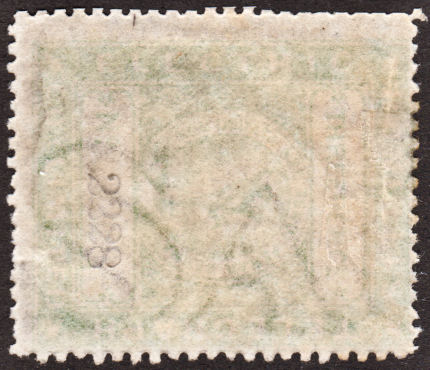 |
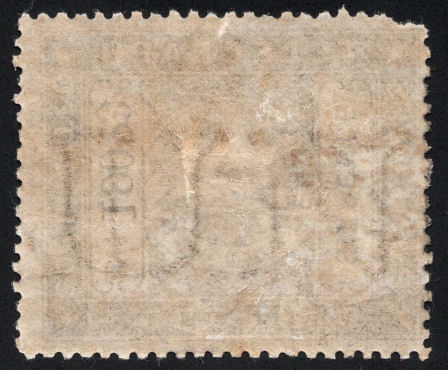 |
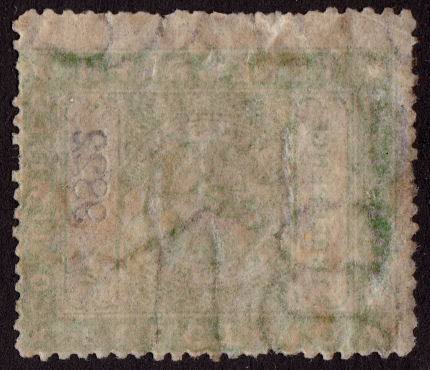 |
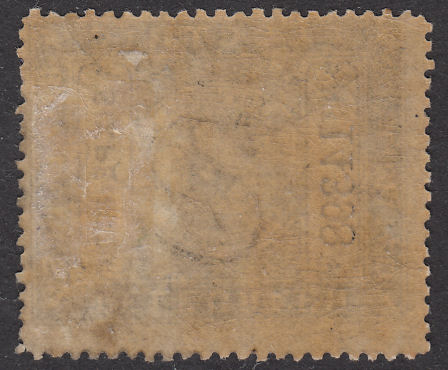 |
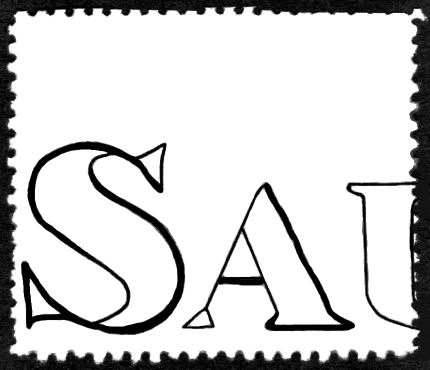 |
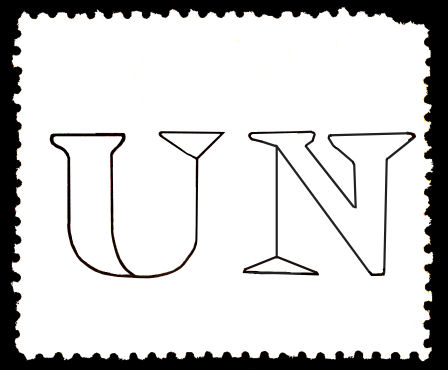 |
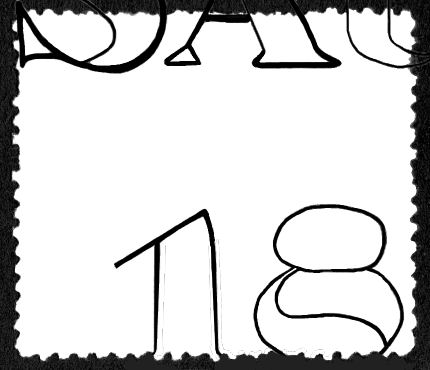 |
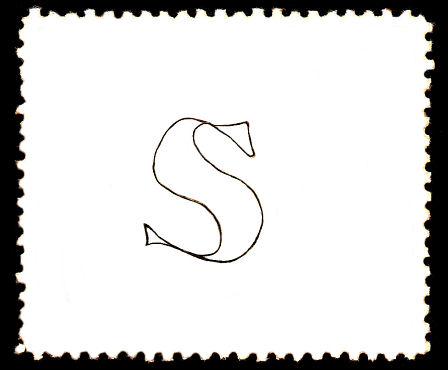 |
| 3d control 2228 (Wmk s/w inv) | 6d control 19023 (Wmk s/w) - Courtesy of Mark Gibson. | 3d control 9822 (Wmk s/w inv., 9812 would be really helpful !) | 6d control 14398 (Wmk s/w) there should be an 'R' before the 'S' |
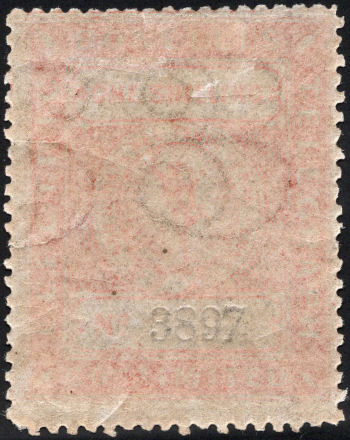 |
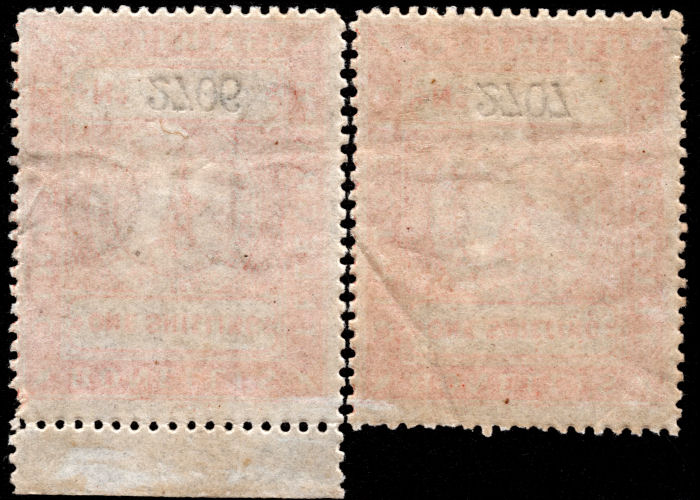 |
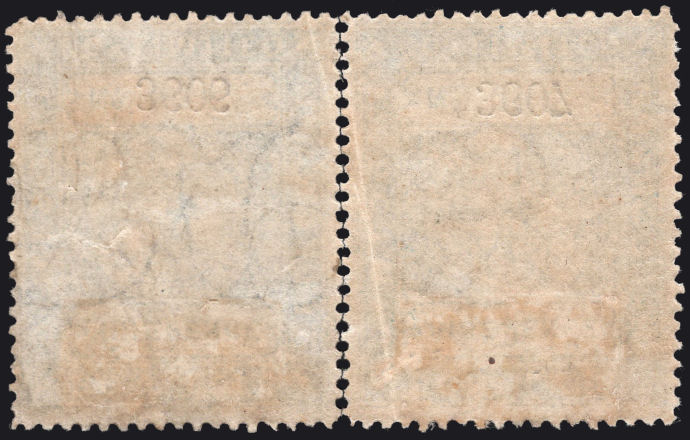 |
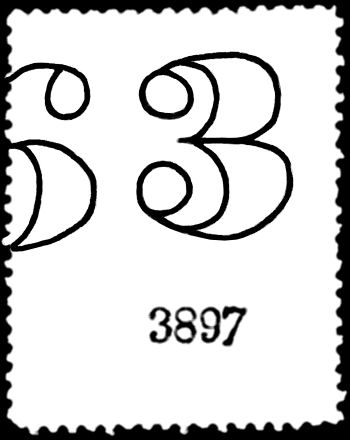 |
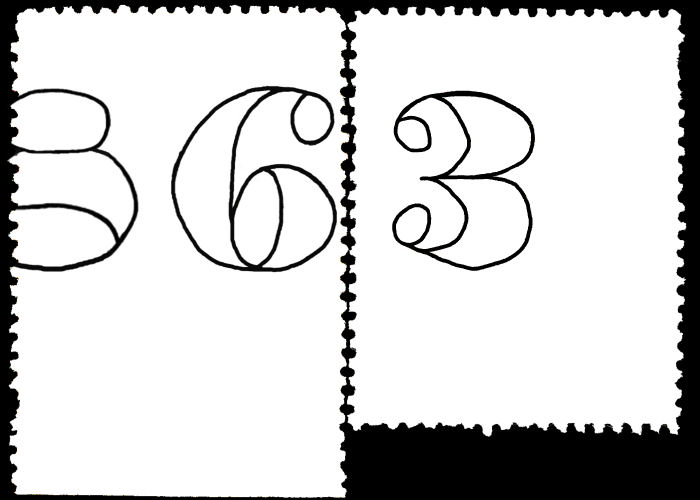 |
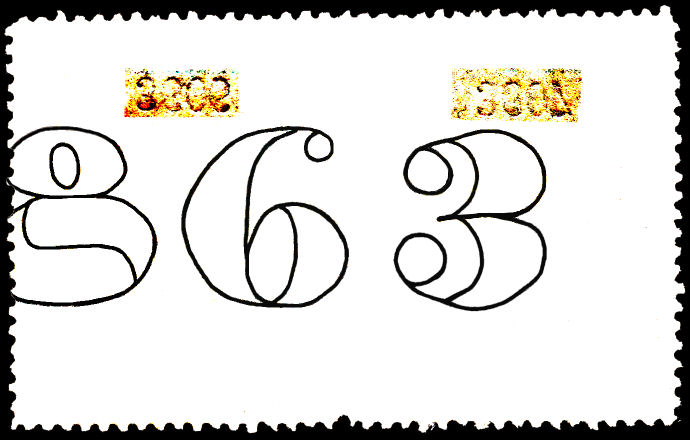 |
| 1/- control 3897 (63 Wmk upright) Courtesy of Mark Gibson. (3884-90 wanted) |
1/- control 2706-7 pair (86 Wmk inverted-reversed) Courtesy of Mark Gibson. (2711-19 wanted) |
9d control 3606-7 pair, enhanced showing "863" (Wmk inverted-reversed) Courtesy of Mark Gibson. (3613-8 wanted) |
Finally we can see the year, at least for the 9d and 1s appear to have been printed in 1863 (thanks Mark). Notice the different orientation of the paper though.
It is possible that the 6d and 3d may have earlier dates on the watermark. The UPT had 1864 on theirs, so perhaps the watermark changed annually.

Approximate reconstruction of the 1863 T. H. Saunders watermark. This is derived from the images above with some filled in from the UPT (1864) watermark which should be similar.
Not all watermark images seem to fit this though. Notice the difference in size between "18" and "63". The "63 is about 8½% bigger."
That is because the "18" is taken from a Saunders example whereas the "63" was taken from an Ansell example before I knew they existed.
It is possible that the actual Saunders date is earlier, 1862 or even 1861 (scans needed). See the Ansell ones below.
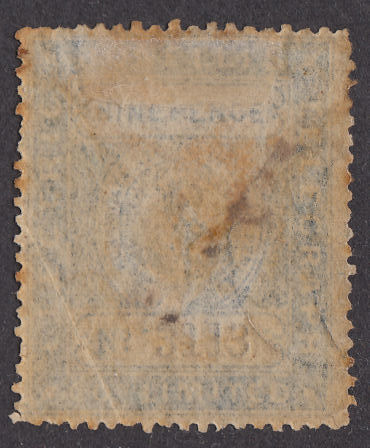 |
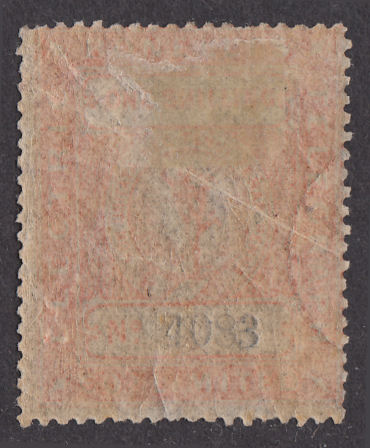 |
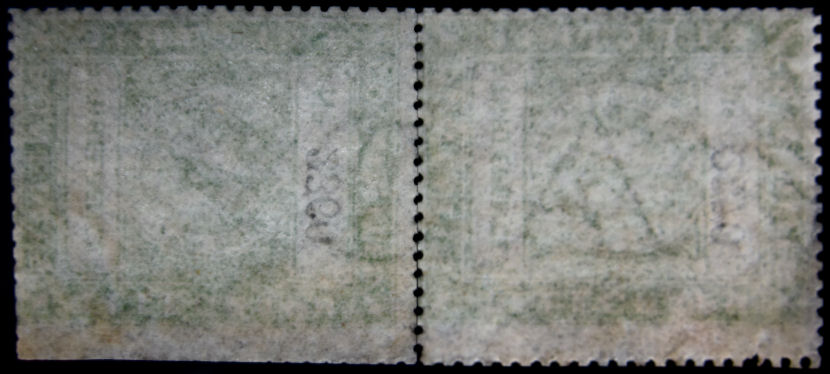 (digitally re-joined pair) of 3d, 2360/70. Normally the date would be below 2370 and 2380, but that would put it in the selvedge. |
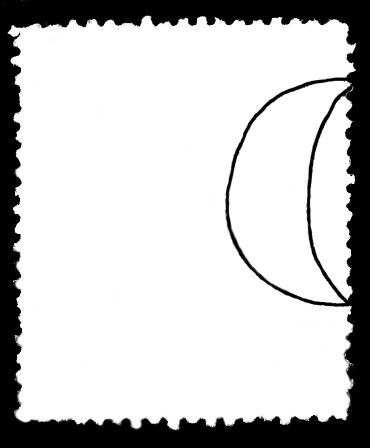 |
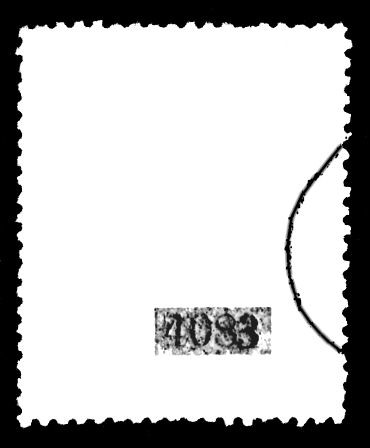 |
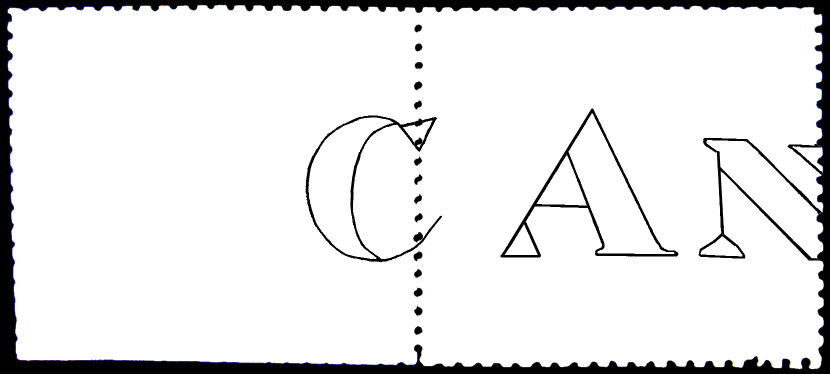 This watermark is smaller than the watermark seen on 9d and 1s stamps. |
| 9d control 3113 (3114-3118 would be very helpful) | 1/- control 4083 (4084-4089 anyone ?) | 3d pair 2360-70 Courtesy of Mark Gibson. (anyone have 2380 or 2390 ?) |
| These did not match T.H.Saunders horizontally, and don't vertically. It could be a Capital C, but is much bigger than the one to the right |
Mark Gibson brought it to my attention that this could be C. Ansell of Carshalton. They also had the year underneath in a font with similar numbers "1", "8" and '3' of the "1863" above. |
|

My attempt to reconstruct the large Ansell watermark. Some is based on images below, some on the image above and some on other Ansell watermarks seen. The date of 1863 would have been somewhere below.
There is a lot of guesswork involved, but gives an idea of relative scale and what to look for.
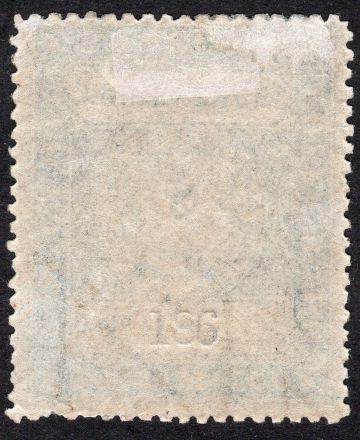 |
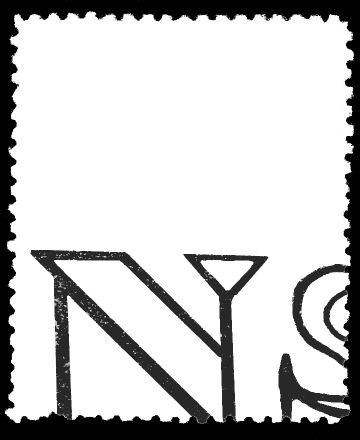 |
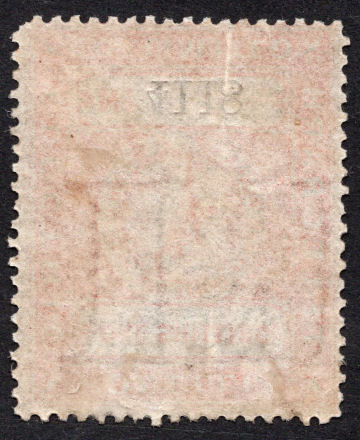 |
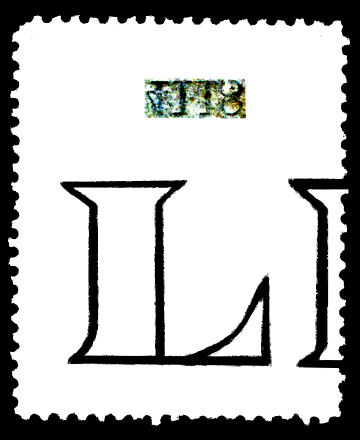 |
| 9d (186 reversed) - letters "NS" courtesy of Mark Gibson. (184-189 and 194-99 needed) | 1s (4118 inverted) - letters "LL" courtesy of Mark Gibson. (4114-17 and 4104-09 needed) | ||
Comparing the "N" on this with the "N" on the pair of 3d above, all to the same scale, the lettering on the high values appears to be much larger than on the 3d. (which is smaller than Saunders)
 | ||
Since the 6d value is the only one known imperf. and perf.12, I presume that it was the first plate made.
The transfer group of 5 stamps for the 3d was then made by copying from the 6d and then
changing the value tablets. This is the source of the famous 'small threepence' variety, and a few other minor defects.
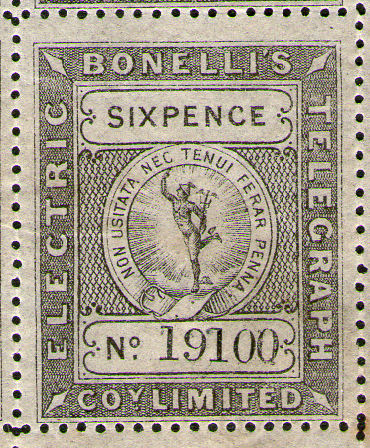 |
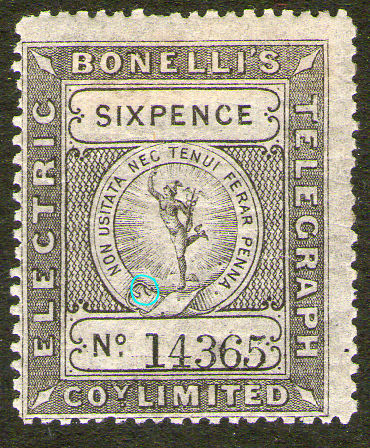 |
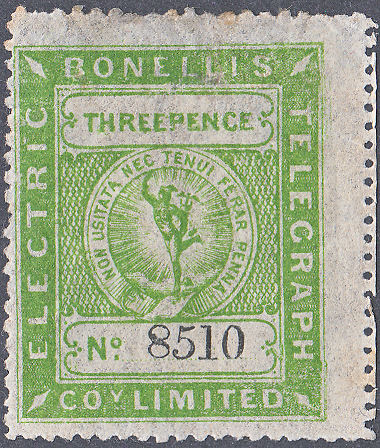 |
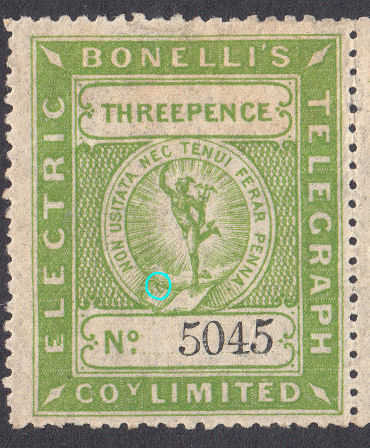 |
The scratch on the buckle occurs on all of the 6d stamps and all of the 3d stamps with the last digit of the control a '0' or '5'.
It does not occur on the 9d or 1s values. It is not on any other 3d or 6d stamps either.
This was not done for the 9d and 1s values. the other flaws (not involving the value tablets) are also the same on the 3d green and 6d.
The plate for the 3d green was produced from the 6d transfer-block by removing the 6d value and inserting 'THREEPENCE'.
Langmead & Huggins (following Hiscocks) note that there are two types of the 3d green with different sizes of the 'THREEPENCE'.
The difference is not easy to distinguish with single stamps, but S.E.R. Hiscocks gives the more helpful note that
in the large type, the 'T' and 'H' are almost touching (as above),
whilst in the smaller type they are well separated.
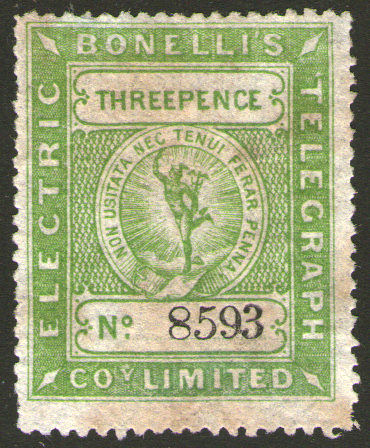 |
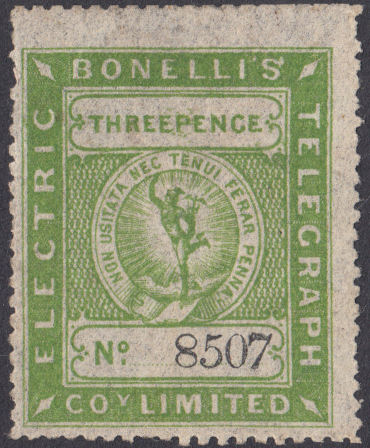 |
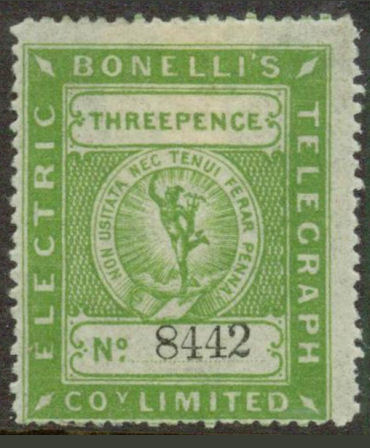 |
| Normal for comparison. | Column 7. | Column 2, courtesy of Roger de Lacy-Spencer. |
The 3d green stamps with small 'THREEPENCE' are on stamps with controls ending with '2' or '7'. The stamps with controls ending in '0' or '5' are almost as small.
This implies that nearly 45% of horizontal 3d green pairs (4 pairs out of 9 per row of 10 stamps) would have a large and small type (L&H Rarity R5).
i.e. (1-2), (2-3), (6-7), (7-8) or 4 pairs in each row of 10 stamps leaving (3-4), (4-5), (5-6), (8-9) and (9-0) which would have both types large.
This fact is quite extraordinary, I can only assume that all pairs of the 3d green are very scarce (it is the only value I do not have as a block of 4).
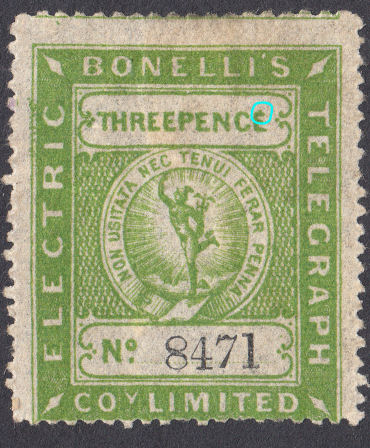 |
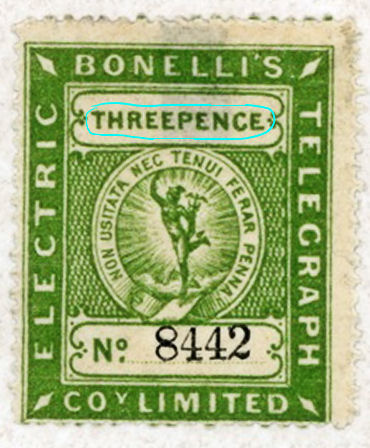 |
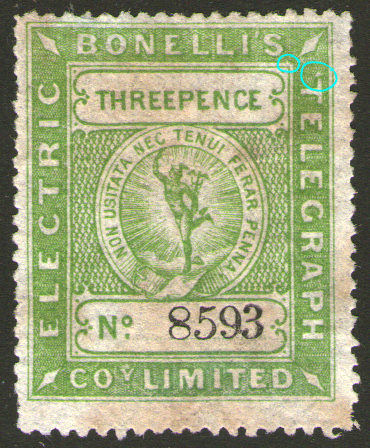 |
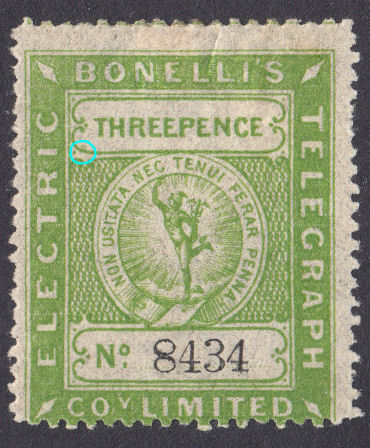 |
 |
| 3d Column 1, as 6d flaws below plus Dot on top of last 'E' in 'THREEPENCE'. |
3d Column 2, as 6d flaws below plus Small 'THREEPENCE'. |
3d Column 3, as 6d flaws below. |
3d Column 4, as 6d flaws below plus Dot bottom-left in value tablet. |
3d Column 5, 6d flaws as below. |
| One of mine. | Courtesy of Mark Gibson. | One of mine. | One of mine. | One of mine. |
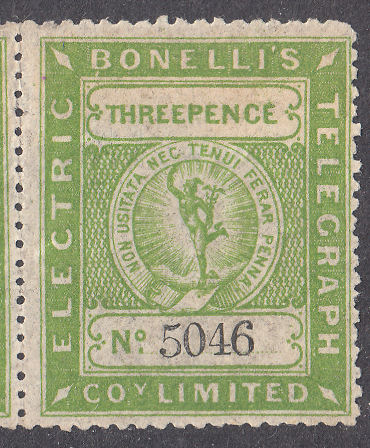 |
 |
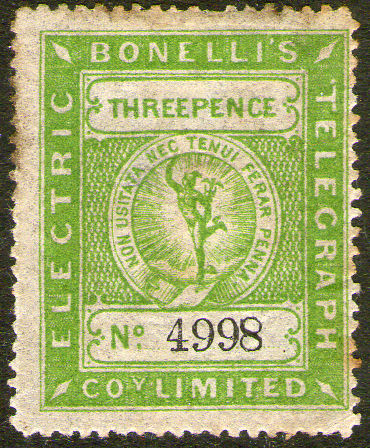 |
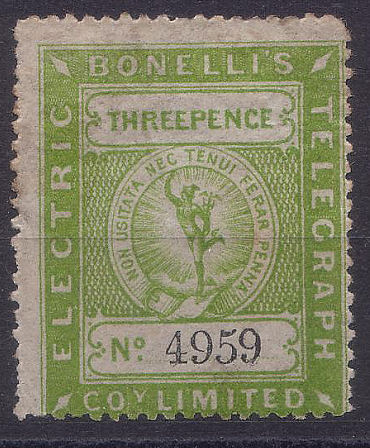 |
 |
| 3d Column 6, as 6d flaws below plus Dot on top of last 'E' in 'THREEPENCE'. |
3d Column 7, as 6d flaws below plus Small 'THREEPENCE'. |
3d Column 8, as 6d flaws below. |
3d Column 9, as 6d flaws below plus Dot bottom-left in value tablet. |
3d Column 0, as 6d flaws below. |
| One of mine. | One of mine. | One of mine. | Courtesy of Steve Lawrie. | One of mine. |
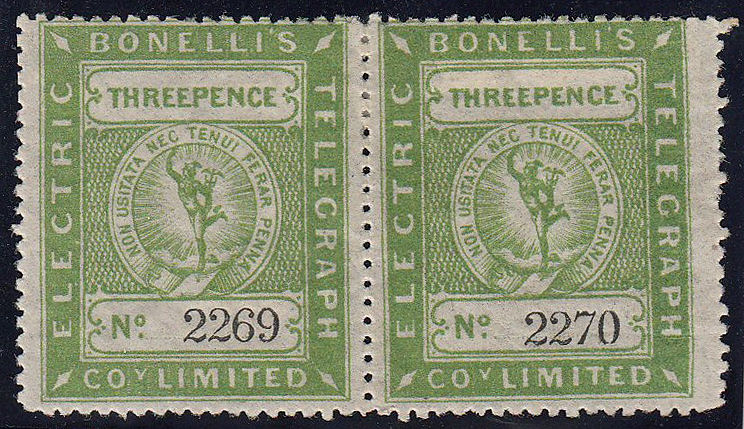 |
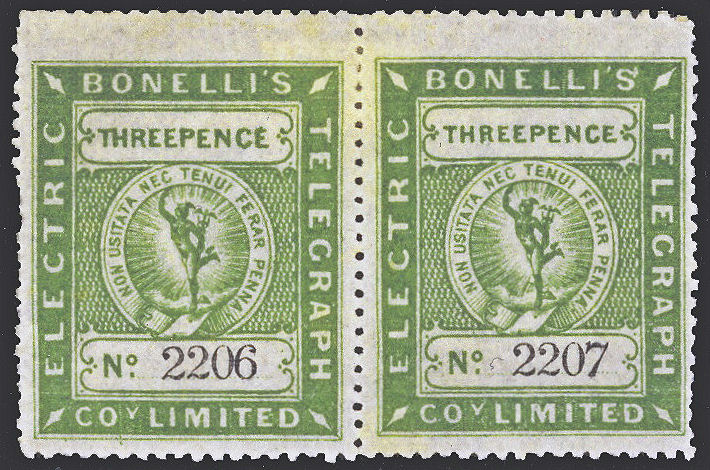 |
| This pair shows that the 'THREEPENCE' on columns 0 and 5 is almost as small as that on columns 2 and 7. Image courtesy of Martien Blank. |
The 2206/7 pair showing different sizes of 'THREEPENCE'. This is from Langmead & Huggins' book (colour plate 2), courtesy of the Great Britain Philatelic Society |
These two pairs are coincidentally from the same sheet. Pairs of these are scarce, I only know of three. I have not seen any larger multiples.
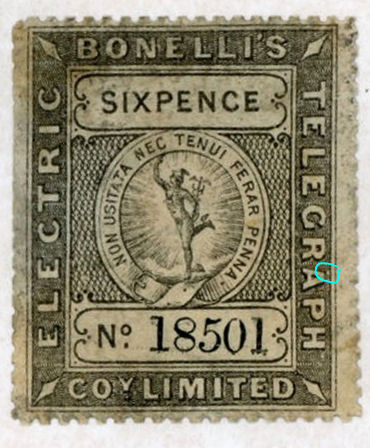 |
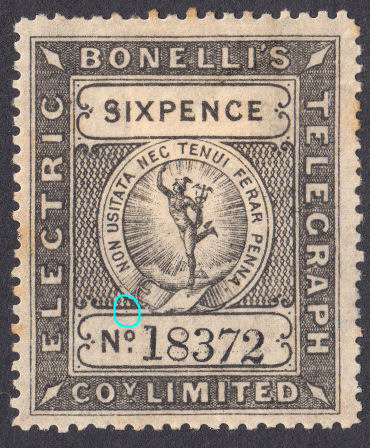 |
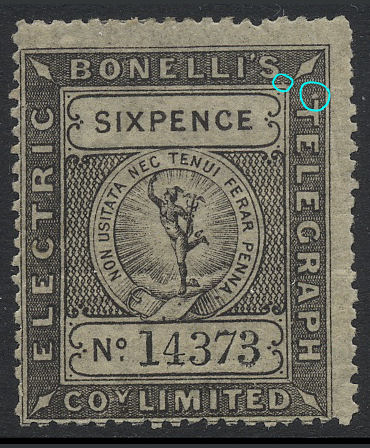 |
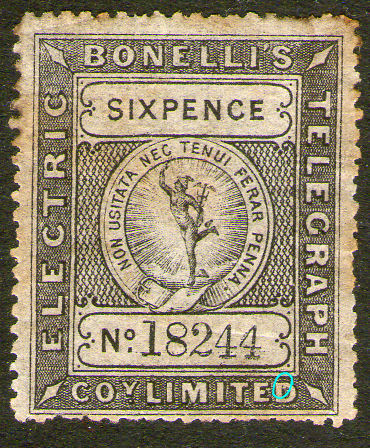 |
 |
| 6d Column 1 Dot over 'A' of 'TELEGRAPH' |
6d Column 2, Dot between lines of Control Tablet above 'o' of 'No'. |
6d Column 3, White dot left of 'T' in 'Telegraph' and broken frame nearby. |
6d Column 4 White spot in top of 'D' in 'LIMITED' |
6d Column 5 Black scratch on Buckle. |
| Courtesy of Mark Gibson. | One of mine. | Courtesy of Mike Jackson. | One of mine. | One of mine. |
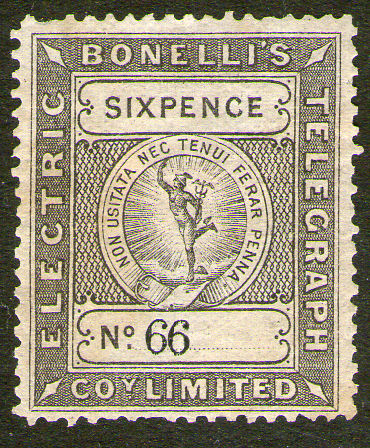 |
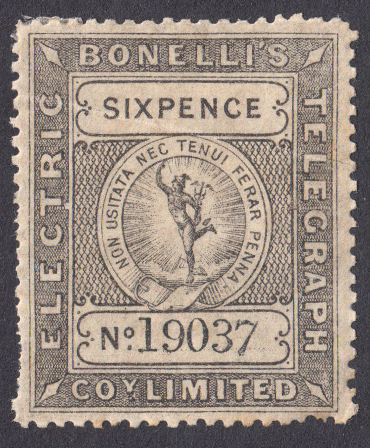 |
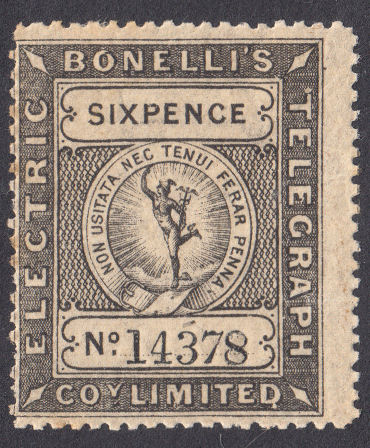 |
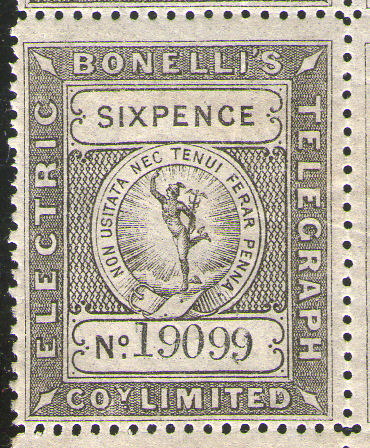 |
 |
| 6d Column 6 White dot over 'A' of 'TELEGRAPH' |
6d Column 7, Black dot between lines of Control Tablet above 'o' of 'No'. |
6d Column 8, White dot left of 'T' in 'Telegraph' and broken frame nearby. |
6d Column 9 White spot in top of 'D' in 'LIMITED' |
6d Column 0 Black scratch on Buckle. |
| According to Langmead & Huggins the 6d has the following printings: |
|
 |
 |
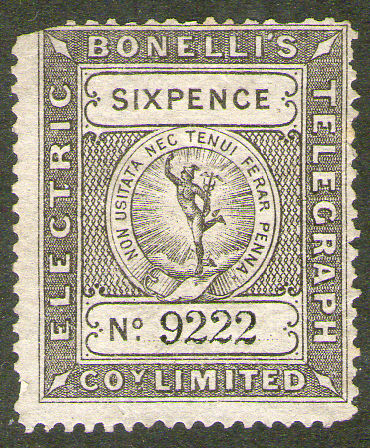 |
| 6d Imperf Proof. RH2b Black | 1st.printing. 6d Perf. 12 RH2a Light Grey | 1st.printing. 6d Perf. 12 Highest known number, 9222 |
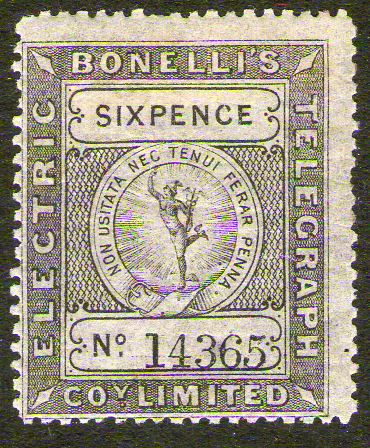 |
 |
| 2nd.printing. 6d Perf. 12¾ RH2 Black | 3rd.printing. 6d Perf. 12¾ RH2 Light Grey |
Personally I see no significant difference between any of these. But then these were all scanned on the same scanner.
Perhaps images created with different scanners by different people would look different.
I would like to see both 'shades' scanned side by side together with the same background.
It would have really helped if Langmead & Huggins had quoted lowest numbers seen as well as the highest known number.
If the intention is to find a boundary, there seems little point quoting a 'known up to' figure without a 'known down to' figure also.
Mark Gibson kindly sent me the scans below as an example of the two shades.
However if 18794 is indeed from the 2nd printing then it considerably extends the number of 14387 given.
The 19023 would seem to be from the same sheet as my example above, although the perforations are well shifted!
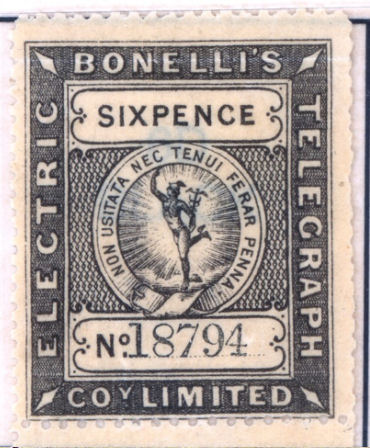 |
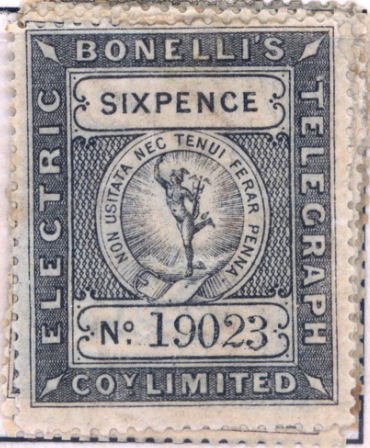 |
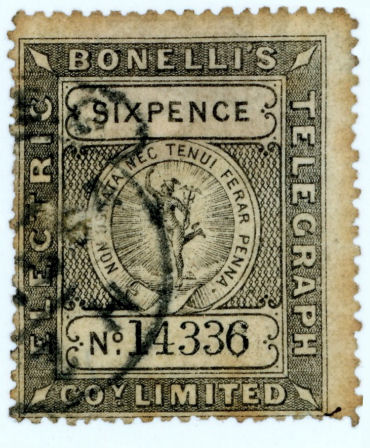 |
| 2nd.printing. 6d control 18794 Black Known up to control 14387 according to L&H ! Puzzlingly, this has the characteristics of a column 1/6 stamp ! See the "6d Anomaly" below. |
3rd.printing. 6d control 19023 Light Grey | 6d with London Postal Hooded Circle cancel of 1894 |
| Images courtesy of Mark Gibson. | ||
Perhaps it is a mistake to scan these with a black background.
Okay, here are some scanned together on white(ish) paper.
What shades are these? Are they all the same? They don't look quite the same, but they are all from the same sheet. An example from row 5, row 6, row 7 and a substituted cliché from row 9.
I'm pretty sure they are all from the same printing, the main difference is that they have spent the last century and a half in different environments, the last 2 looking more yellowed.
I can believe the first 100 sheets were from the same printing because they were all Perf.12. It is also possible that the next 100 sheets were in two printings of 50.
That would give 1st. printing numbered 1 - 10,000 (perf.12)
2nd. printing numbered 10,001 - 15,000 (perf.12½)
3rd. printing numbered 15,001 - 20,000 (perf.12½)
But I am not convinced that the perceived shade of grey is a meaningful distinguishing factor. The eye sees the overall appearance of the stamp, not just the colour of the ink.
Here is something from the Steve Lawrie collection:
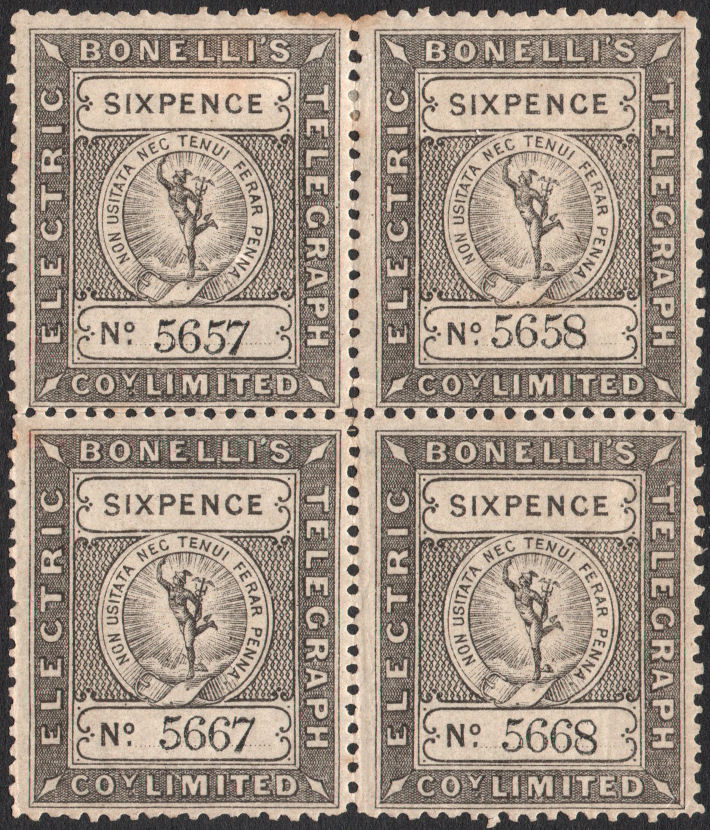
This is a Perf. 12 block of 4. It looks like it has some reinforcement, but any blocks of Bonelli are quite scarce, and this Perf.12 block may be unique.
It has become apparent that there has been some plate repairs done to the 6d by Substituting clichés on the bottom row.
It is possible that other locations have had the same done, but I am only aware of 2 locations on the bottom row so far.
It is likely due to the exposed nature of the edges of the plate, so other examples would likely to be on the edges.
I would like to know at what stage the repairs were made, so I will show the bottom row stamps that I have seen and indicate the substitutions known.
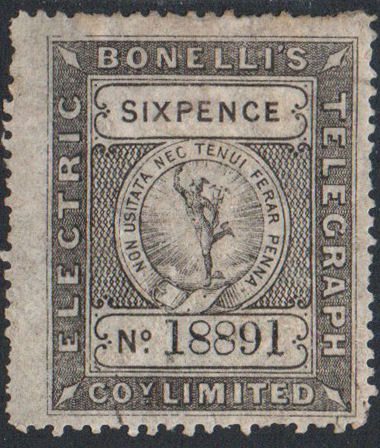 |
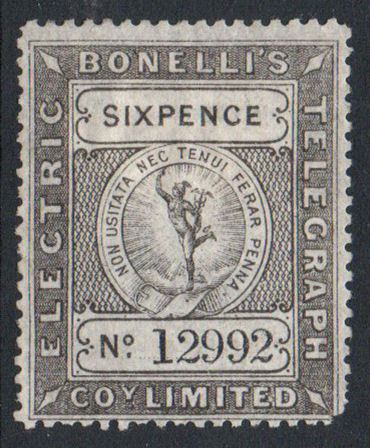 |
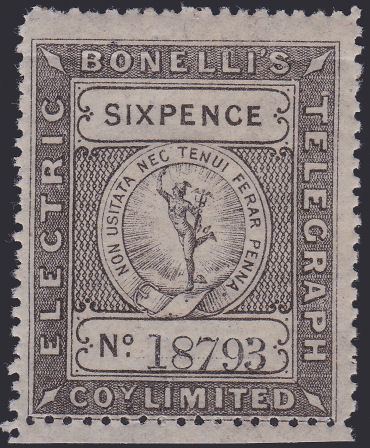 |
 |
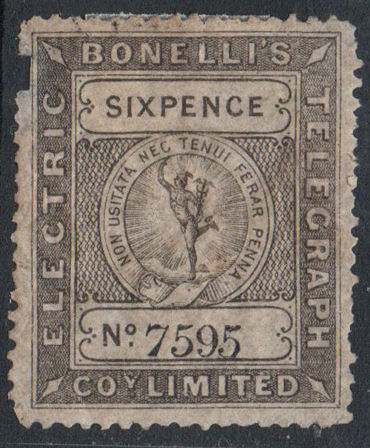 |
| 18891 - Normal Dot over 'A' of 'TELEGRAPH' |
12992 - Normal, Dot between lines of Control Tablet above 'o' of 'No'. |
18793 - Normal, White dot left of 'T' in 'Telegraph' and broken frame nearby. |
18794 - SUBSTITUTED from 1/6 Also known on 19094. |
7595 - Normal Perf.12 Black scratch on Buckle. |
| Courtesy of Steve Lawrie. | Courtesy of Steve Lawrie. | One of mine. | Courtesy of Mark Gibson. | Courtesy of Steve Lawrie. |
 |
 |
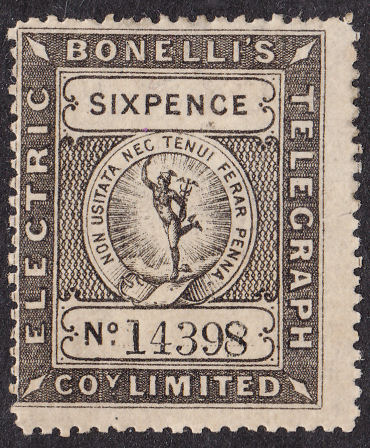 |
 |
 |
| 6d Column 6 White dot over 'A' of 'TELEGRAPH' |
6d Column 7, Black dot between lines of Control Tablet above 'o' of 'No'. |
14398 - SUBSTITUTED from 0/5 Also known on 18498 and 19098. |
19099 - Normal White spot in top of 'D' in 'LIMITED' |
19100 - Normal Black scratch on Buckle. |
| Image needed | Image needed | One of mine. | One of mine. | One of mine. |
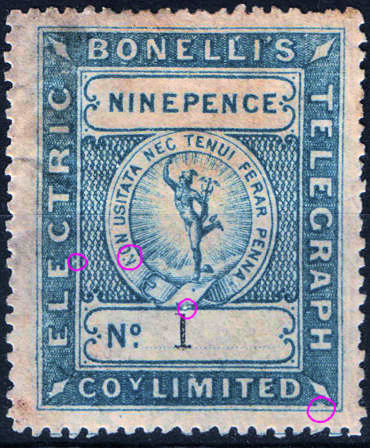 |
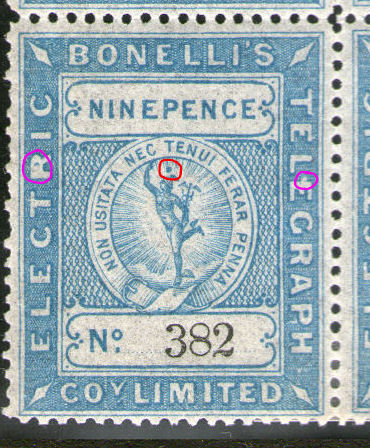 |
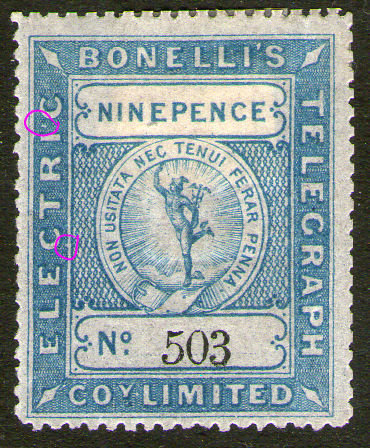 |
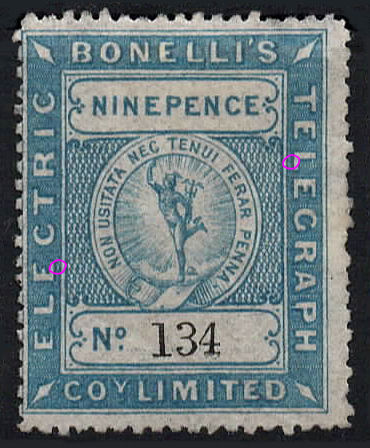 |
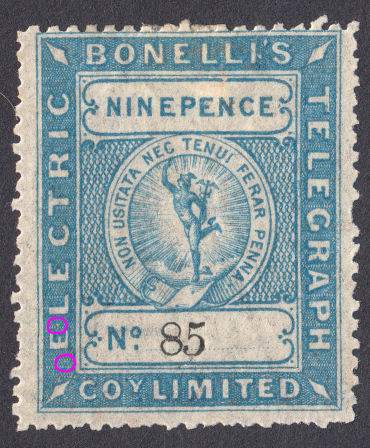 |
| 9d Column 1, White marks bottom-right corner and below 2nd. 'E' in 'ELECTRIC'. Broken 'N'. |
9d Column 2, Blemishes on 'R' of 'ELECTRIC', 2nd.'E' of 'TELEGRAPH', dot over head on some. |
9d Column 3, White mark between 'I' and 'C' of 'ELECTRIC'. |
9d Column 4, Shadow under 'L' in 'TELEGRAPH', white mark under 'E' of 'ELECTRIC'. | 9d Column 5 Dot each side of 1st. 'E' of 'ELECTRIC'. |
| Courtesy of Robert Poposki. | One of mine. | One of mine. | Courtesy of Steve Lawrie. | One of mine. |
| For 4/9 both of the flaws have variable clarity. In practice it may be easier to check that it is none of the others. . | ||||
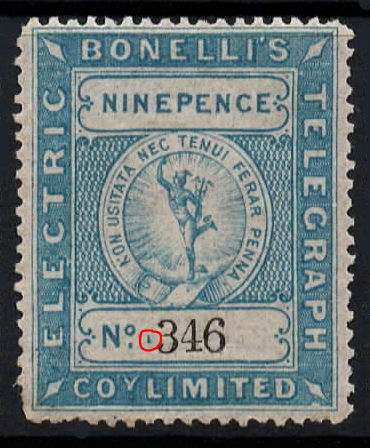 |
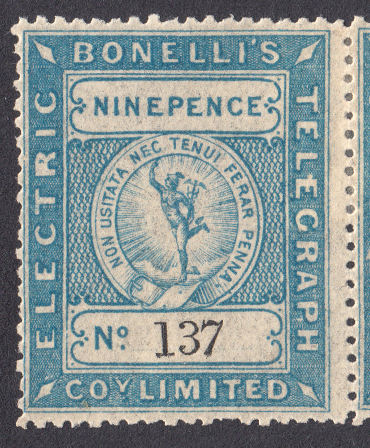 |
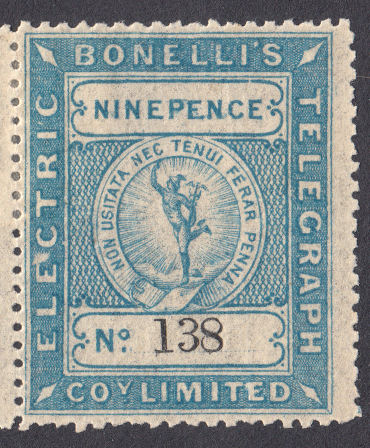 |
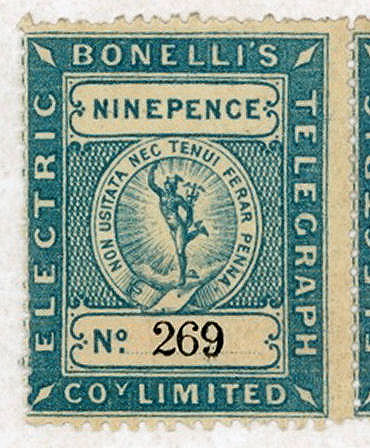 |
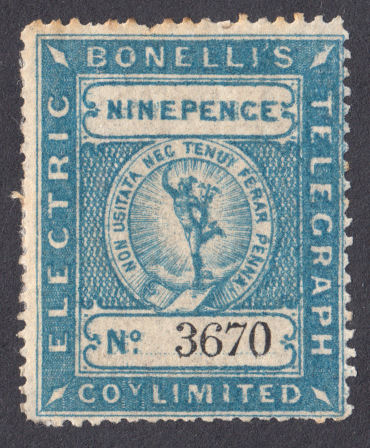 |
| 9d Column 6, White marks bottom-right corner and below 2nd. 'E' in 'ELECTRIC'. Broken 'N'. The mark in the serial number panel is on some. |
9d Column 7, Blemishes on 'R' of 'ELECTRIC', 2nd.'E' of 'TELEGRAPH', often dot over head. |
9d Column 8, White mark between 'I' and 'C' of 'ELECTRIC'. |
9d Column 9, Shadow under 'L' in 'TELEGRAPH'. |
9d Column 0 Dot each side of 1st. 'E' of 'ELECTRIC'. |
| Courtesy of Steve Lawrie. | One of mine. | One of mine. | Courtesy of Mark Gibson. | One of mine. |
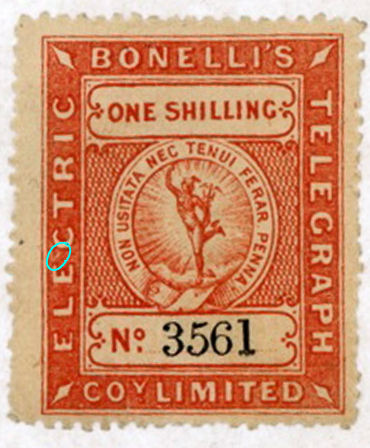 |
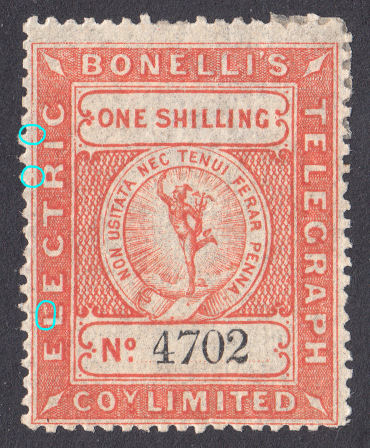 |
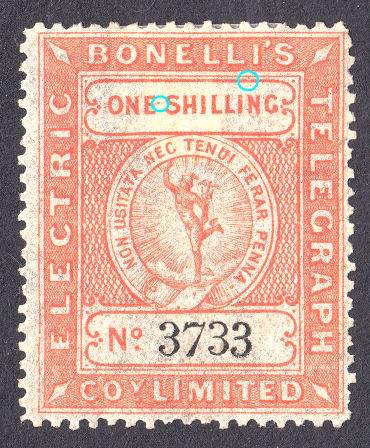 |
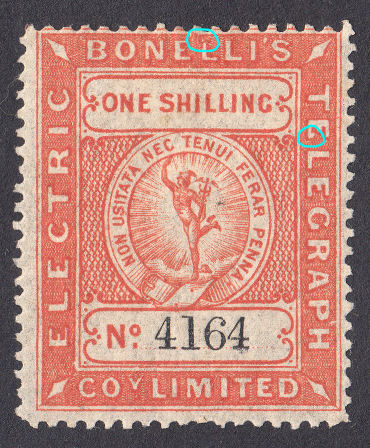 |
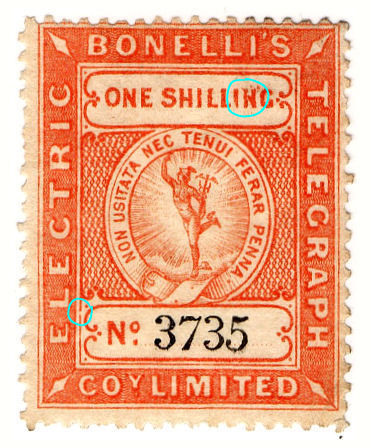 |
| 1s Column 1, White scratch between 'E' and 'C' of 'ELECTRIC'. |
1s Column 2 White mark top-right of 'L' in 'ELECTRIC'. |
1s Column 3, Line above 'N' of 'SHILLING' indented with dot, and other mark before it. |
1s Column 4, Shortened 'L' and Deformed first 'E' in 'TELEGRAPH'. |
1s Column 5, Frame break left of serial tablet and damaged 'IN' in 'SHILLING'. |
| Courtesy of Mark Gibson. | One of mine. | One of mine. | One of mine. | Courtesy of www.ibredguy.co.uk |
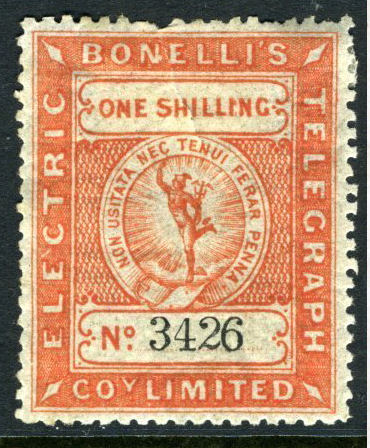 |
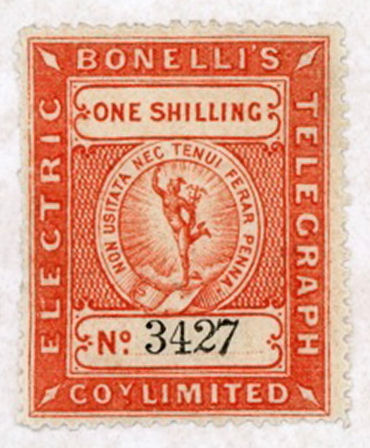 |
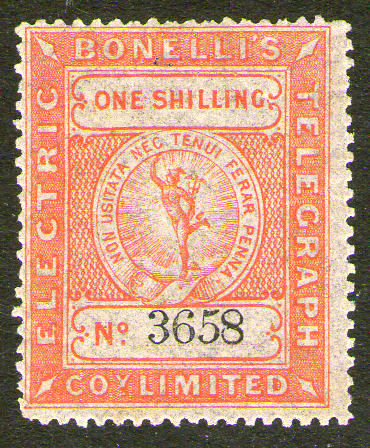 |
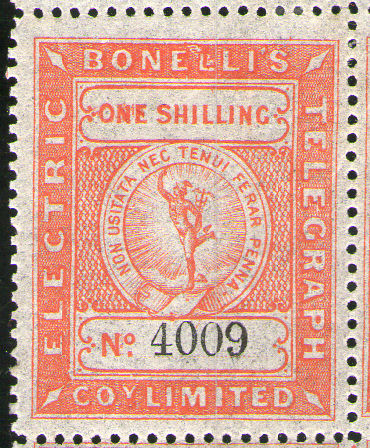 |
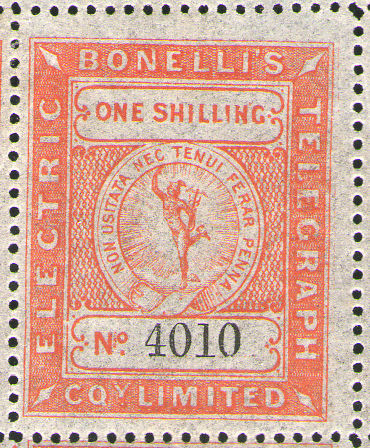 |
| 1s Column 6, White scratch between 'E' and 'C' of 'ELECTRIC'. |
1s Column 7 White mark top-right of 'L' in 'ELECTRIC'. |
1s Column 8, Line above 'N' of 'SHILLING' indented with dot, and mark before it. |
1s Column 9, Short 'L' and Deformed first 'E' in 'TELEGRAPH'. |
1s Column 0, Frame break left of serial tablet and damaged 'IN' in 'SHILLING'. |
| Anonymous | Courtesy of Mark Gibson. | One of mine. | One of mine. | One of mine. |
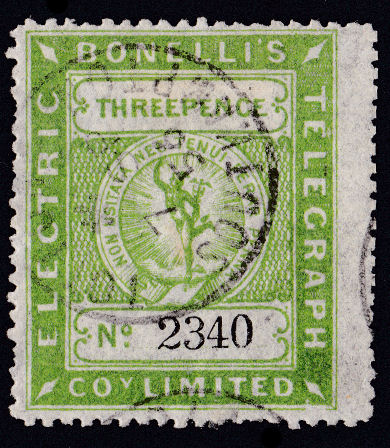
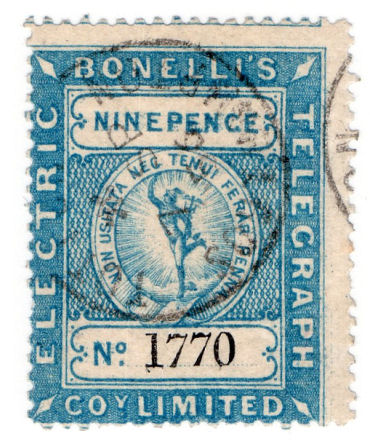
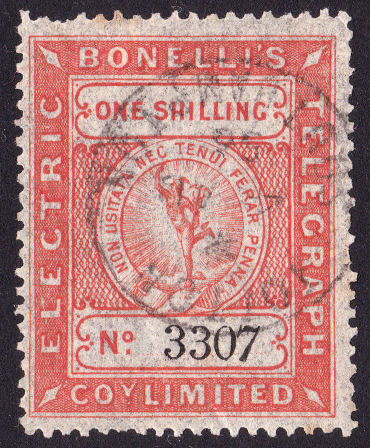
Some joker in 1956 decided to get postal cancellations on some telegraph stamps. They are cancelled in Totton, Southampton.
The 3d and 9d are dated 7 September 1956 and the 1s is dated 4 August 1956.
The 3d and 1s still have full gum, so were presumably cancelled by favour. I don't know about the 9d.
This cancel is also known on stamps of the English & Irish Magnetic Telegraph Company and the London District Telegraph Company (Limited).
9d image courtesy of www.ibredguy.co.uk. The other two are mine.
A 6d stamp with an 1894 London Hooded Circle postal cancel is shown above.
To me the variation in shade of the later booklet 3d (RH5) is much more noteworthy than the 6d, but doesn't get a mention!
These are to the same scale as the ones above. The stamps are longer to allow for a larger control tablet. 18714 below is the highest number I have seen.
With the 3d green, the control numbers were smaller to allow for more digits. The fact that these are re-designed and now the digits are larger has implications.
Presumably the 3d green was produced before booklet stamps were envisaged and the booklets had to be numbered by hand.
This suggests that the sheet stamps were numbered by machine. The earlier stamps have the imprint of Waterlow & Sons, London at the bottom of each sheet.
These have no imprint, and it is not known which company produced them.
It is normally stated as fact that these were all numbered in a serpentine manner. However I have found that not all of them were.
Some were numbered in the conventional manner. For the evidence, see my Bonelli's_Proof page.
Hiscocks and Lister say no watermark, however Mark Gibson brought it to my attention that there is in fact a watermark on some of these also.
These have a sheet watermark of double-lined 'A PIRIE & SONS' (Alexander Pirie and Sons, Stoneywood Mill, on the river Don near Aberdeen in Scotland).
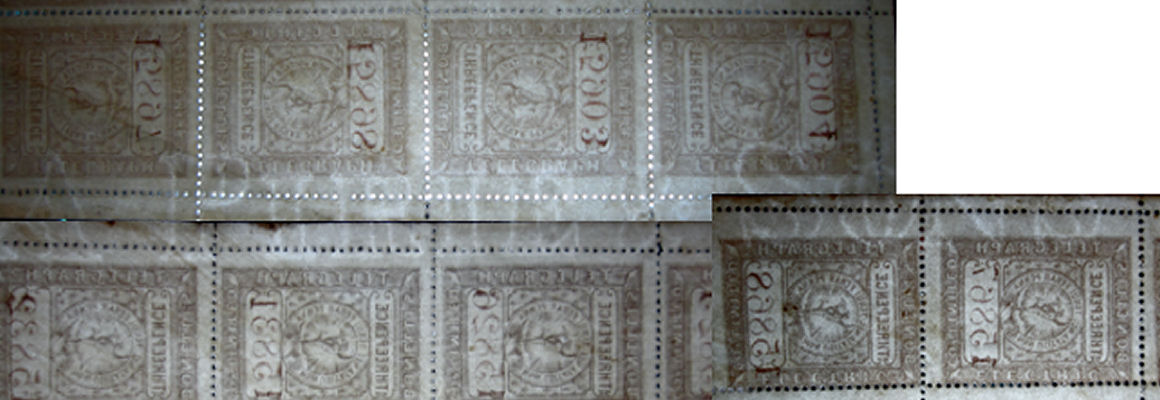
A collage of images from 3 pages of the same booklet of 7 pages. the other 4 pages had no watermark - images supplied by Mark Gibson.
I subsequently checked mine and found 2 out of 25 with part of the watermark.

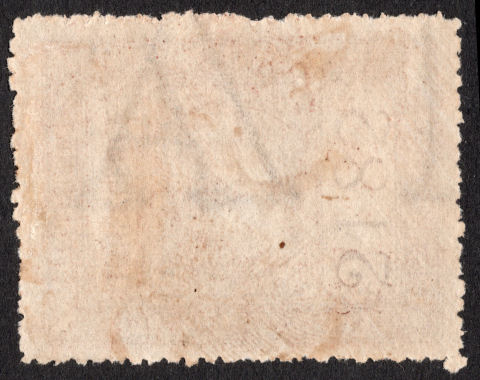
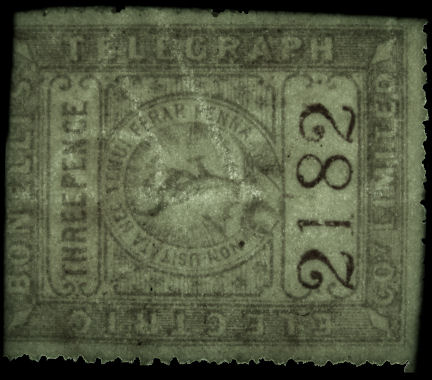
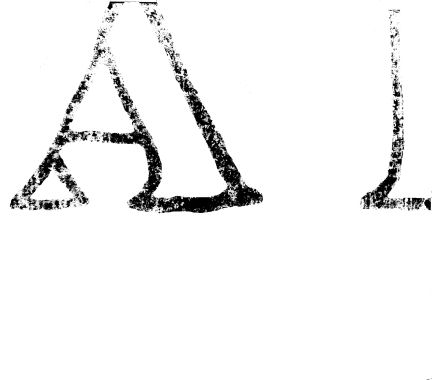
Stages of trying to render the watermark with the "A" and part of the "P" of "PIRIE". Images courtesy of Mark Gibson.
For the sake of interest, a photograph showing a 1915 version of the Pirie watermark on a document

This has thinner lettering and the year underneath, something apparently lacking on the Bonelli version. It would have been nice to have a date for it.
Images courtesy of Mark Gibson.
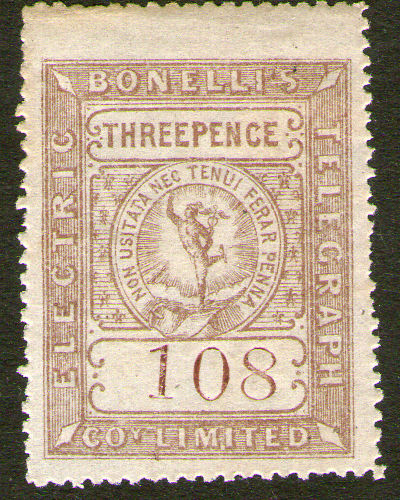
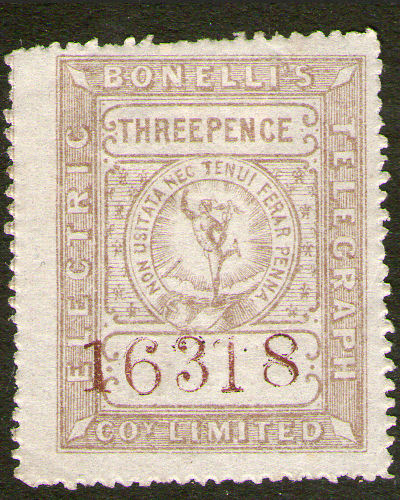
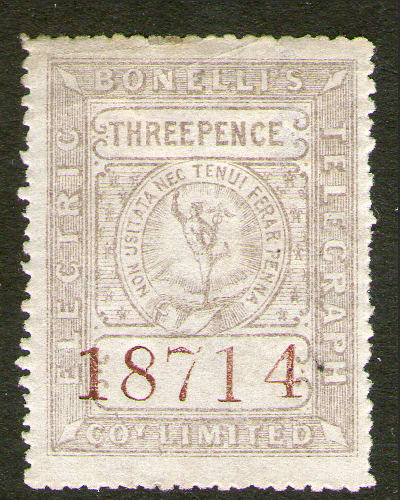
The quality of the perforations is much poorer on these. The quality of the printing is also rather questionable.
Printing them on paper produced near Aberdeen, would be sensible if they were printed in Northern England or Scotland.
There were two types of booklets, both had 7 pages with 3 stamps to a row.
One type had 2 rows, the other 4 rows of stamps per sheet and were numbered in a serpentine fashion.
It is generally assumed that Waterlow & Sons produced the booklet stamps as well as the sheet stamps.
I have not seen their imprint on any of the booklet stamps however.
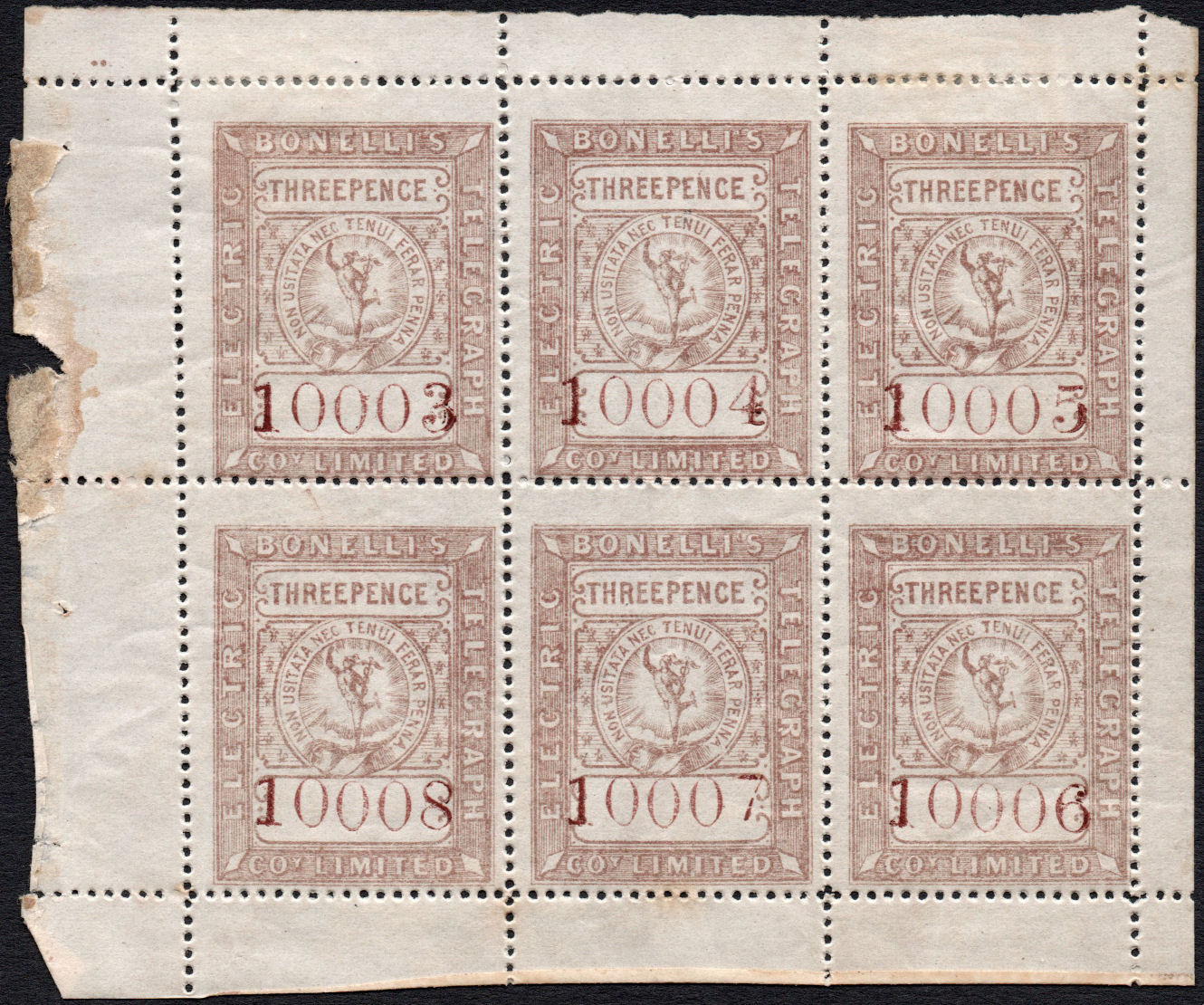 |
| A 3 x 2 booklet pane of 6, showing serpentine numbering. |
| Full-size image (but displayed half size) courtesy of Steve Lawrie. |
The red numbers are the control numbers modulus 6, explained below.
One thing I find puzzling is that, if we assume these were both panes of 6 stamps, then between them were controls 15835 through 18628.
This represents 2794 stamps (18628 - 15835 + 1). This represents 465 panes of 6 plus 4 stamps ?
Since these two blocks represent the same positions in a pane, I thought I would compare them for similar details.
This was not simply because I had too much time on my hands. I had been puzzling over LDTC stamps for a while,
it seems that while some make a regular pattern, some do not.
I wondered if it was because some were booklet and some were not. This made me think of the Bonelli's.
Because of the serpentine pattern of the control number, there is no easy way to find position from the control number.
Taking modulus 6 (the remainder left when dividing by 6) of the Control Numbers is helpful.
If the numbering started at control number 1 and the numbering remained consistent, the mod-6 numbering on the
booklet pane above should have started at 1, not 5. It is out of sync by 2.
I refer to this as displacement-2. It will be seen that the displacement varies and the numbering is sometimes NOT consistent.
Here are the most noticeable constant flaws for the repeating unit of 6 stamps.
I have included the mod-6 value, assuming displacement-0, as they presumably started.
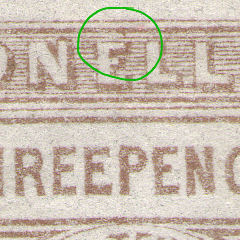 E-flaw-a. Mod 6 = 1 |
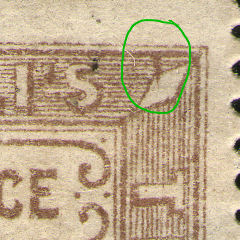 Dagger flaw. Mod 6 = 2 |
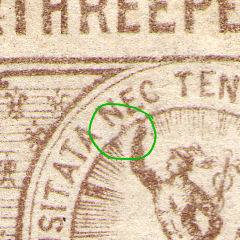 N-flaw. Mod 6 = 3 | 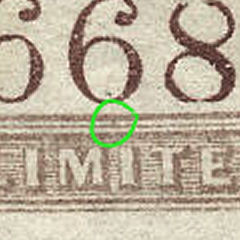 N-flaw alternative. Mod 6 = 3 |
|
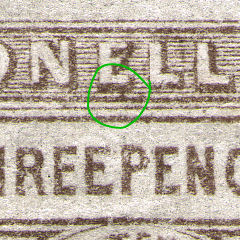 E-flaw-b. Mod 6 = 0 |
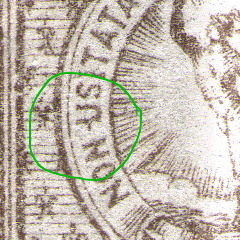 U-flaw. Mod 6 = 5 |
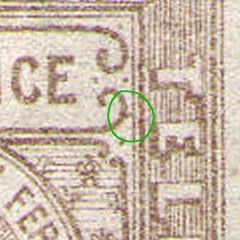 Scroll-flaw. Mod 6 = 4 | The flaw above is on the same stamps as the N-flaw, but the N-flaw is not always clearly visible, so this may sometimes help. It can be seen below on: 2583, 13735 and 1668. |
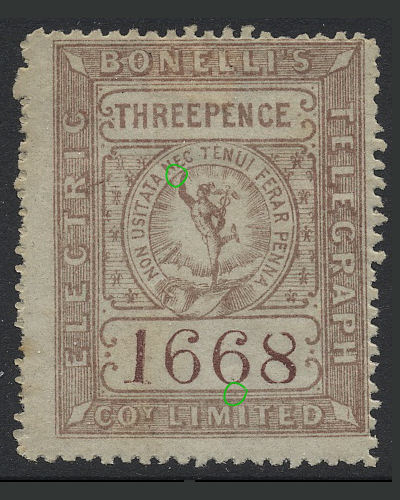 |
||
| E-flaw-b gradually changes as the plate ages. | 1668 (Courtesy of Mike Jackson) had me puzzled for a while. It has the same flaw in the bottom-right diamond as the 3 above. It is between a Displacement-3 and a Displacement-2 group so should have E-flaw-b or N-flaw. But I couldn't see either. Then I noticed the small mark above 'MI' at the bottom. It matches the two above with the N-flaw. Perhaps this flaw first appears somewhere between 1668 and 2583, or perhaps it is weak on this stamp. Anyway, 1668 is in the Displacement-3 group |
|
For those that have found the arguments a bit tenuous so far, thankfully I can now show you a booklet pane that makes it more salient
The lowest number on this pane is 18275. The lowest number on the pane shown above is 15823, a difference of 2452, representing 204 panes of 12 plus 4 stamps.
The argument is about how this 4-stamp anomaly arose and the consequences.
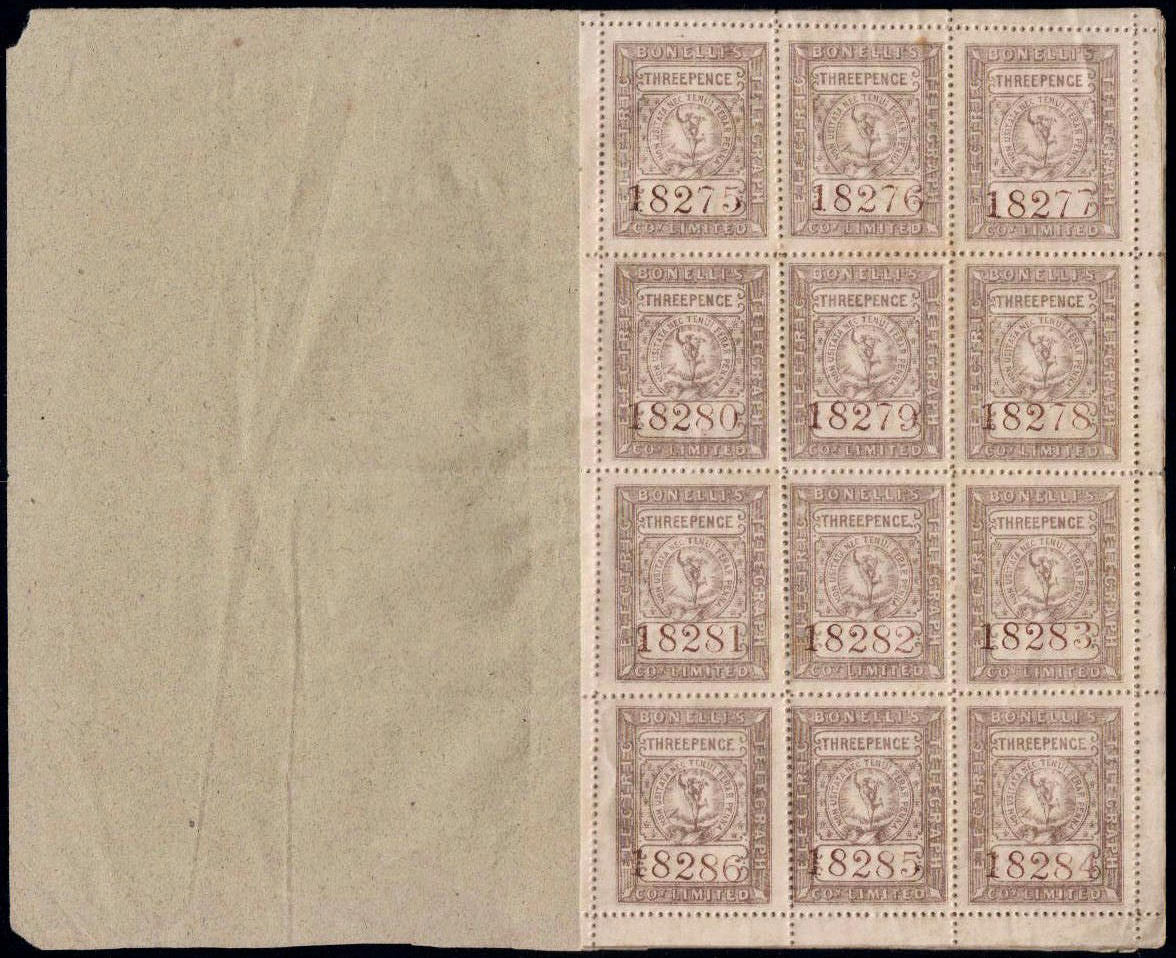
Can you see the two with 'dagger flaws' ? Image courtesy of
Paul Ramsay
These numbers are there for accountancy purposes.
The Victorians took accountancy very seriously and to their credit the numbering is in general very reliable.
4 x 3d = 1/- which is not insignificant in Victorian days, 3d coins were made of silver.
The discrepancy could be the result of one incident or several. Since such incidents seem rare, let us assume for the moment it was just one.
At the moment we know that this discrepancy took place between 16318 and 17141,
a range of 823 stamps or less than 69 sheets, quite a narrow range for more than one mistake.
Off-hand I can think of three possible scenarios:
| 1) Somehow a mistake wasted 4 numbers ( + 0 or more sheets) and numbering was continued without resetting the counter. |
| 2) The numbering machine was used for other things. The counter being set as needed for each job. At one point the counter was set 100 too high (8 sheets + 4 stamps). |
| 3) 4 stamps were numbered 'By Favour' for a V.I.P. |
I spent some time trying to pin down the boundaries of the displaced groups.
anyone wanting the (painful) details can find it on the Bonelli's_Proof page.
Here are my current findings (so far):
By conventionally I mean that they have been numbered left to right on each row,
instead of the expected serpentine procedure. Contrary to common belief, these were not all numbered in a serpentine manner:
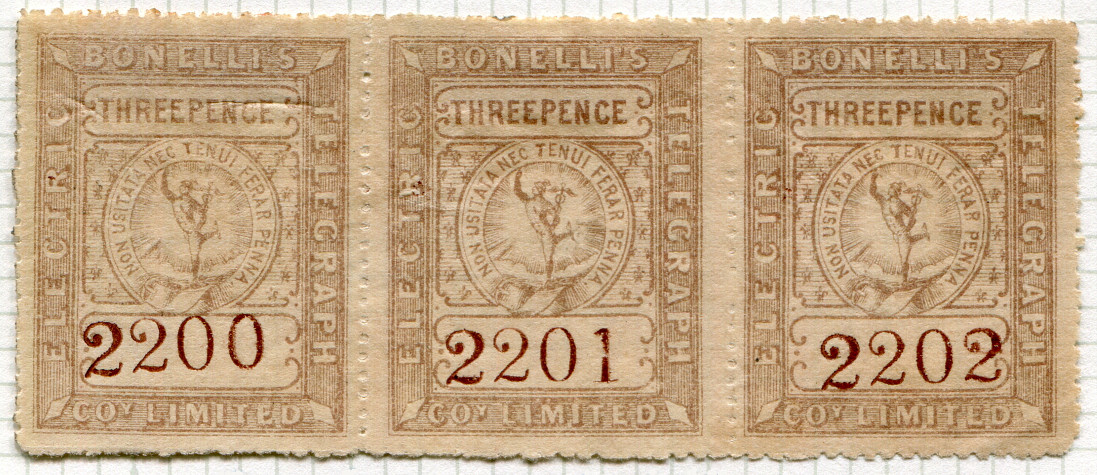
These are conventionally numbered displacement-0 - Courtesy Grosvenor Auctions (Ex. Iain Stevenson).
Any of these ranges may contain pockets of something different
I have included this information in the 'widgit' tool below to help identify flaws, and to help identify further inconsistencies.
I would appreciate information with a scan of any examples that break the known pattern or narrow the boundary areas.
Enter a Control number to check
 |
 |
 |
 |
 |
 |
| Displacement-0 group. | Displacement-1 group. | Displacement-2 group. | Displacement-3 group. | Displacement-4 group. | Displacement-5 group. |
The 'widget' above will correctly show the flaws on 80%+ of the booklet stamps and
show the possibilities for the ones where I have not yet determined the 'displacement'.
It will also flag if the number entered is a new 'highest known' control number.
Please send a scan of any it gives the wrong results for.
| The fact that I found it hard to get a scan of the top-right stamp of the booklet pane might tempt me to think that it was because they preferentially got used first. However, since everyone knows that the Bonelli's were never used, that cannot be the reason. This last is a test for you, Another (digitally) reunited pair. Are these numbered in the correct sequence? |
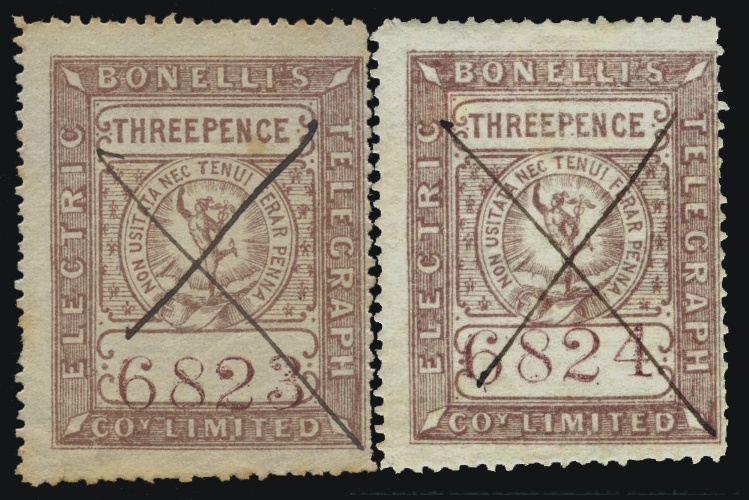 |
| For an alternative explanation see booklet precancels | 6823 Courtesy of Mike Jackson, 6824 Courtesy of Mark Talbot. |
Langmead & Huggins say they have seen the following booklets of 84 stamps (7 x 12) for a face value of 21s (1 guinea) :
(1) 14479 - 14562
(4) 18863 - 18946
In addition Steve Lawrie has:
(2) 15823 - 15906
(3) 17027 - 17110
Steve Lawrie's lowest is in a Displacement-0 area, and L&H's low numbers are too.
Steve Lawrie's highest is in a Displacement-2 area.
Taking the last stamps in the booklets:
L & H report "imperf. between in booklets with Controls 2995/3276" (82 stamp booklet!?).
10003 to 10008 is a booklet pane of six.
Last updated 11th. September 2023
©Copyright Steve Panting 2012/13/14/15/16/17/18/19/20/21/22/23 except where stated.
Permission is hereby granted to copy material for which the copyright is owned by myself, on condition that any data is not altered and this website is given credit.